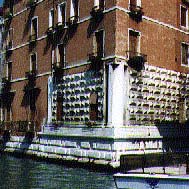Ca' del DucaGrand Canal, S. Samuele Parish (S. Marco) In 1456 Andrea Cornaro (B-17) commissioned the stonemason-architect Bartolomeo Buon to design a palace for the large site that Andrea and his brother Cav. Marco Cornaro (B-16) had acquired on the Grand Canal. Construction began in the following year. Unfortunately, 1457 was also the year in which Andrea Cornaro was banished from Venice for allegedly buying his election to the Zonta del Pregadi. Construction continued for a while under Marco's supervision, but in 1461 the property was sold to Francesco Sforza, Duke of Milan, for 20,000 ducats. Of the price, 12,000 ducats was satisfied by Sforza's transferring to the Cornaro brothers his palace in Campo S. Polo, previously the property of the famous condottiere Gattamelata [later, following a fire, rebuilt as Ca' Cornaro and now sometimes called Ca'Cornaro-Mocenigo]. The balance of the price was payable in six equal annual installments. The Cornaro brothers were also appointed Sforza's financial agents for completing the palace. More importantly for the Cornaro family, however, through the transaction Marco sought to obtain Sforza's assistance in convincing the Pope to grant his brother Andrea an ecclesiastical office, in order to bring an end to Andrea's banishment from Venice. (In his exile Andrea removed to Cyprus, where he provided financial assistance to King James II Lusignan in gaining the throne and conceived the idea for the subsequent marriage of his brother Marco's daughter Caterina Cornaro (B-31) to King James.) The sale to Sforza interrupted construction of the Cornaro palace after completion of only the foundation and a corner of the first floor. Before further work was undertaken, the Duke lost the property in 1466 as a result of a political dispute with Venice. Later, two undistinguished buildings were erected on the original foundation. Had the original structure been completed, it would have been the largest private palace in the city. The incomplete Cornaro segment is frequently cited for its pioneering use of several characteristic Renaissance motifs. Lieberman comments in Renaissance Architecture in Venice (pl. 57): "Even in its truncated state the Ca' del Duca is powerful and impressive, and introduces several new features to Venice. The variety of the sharply accented stonework of the basement and ground floor is in marked contrast to any building built in the city before this time. The basement level in most Venetian palaces is usually completely undecorated; here it is composed of carefully marked Istrian stone blocks. In this detail the Ca' del Duca influenced a number of later palaces. . . . The faceted blocks of the ground storey are also a novel element in Venice. The slightly projecting corner units of the palace derive from a fortified castle tradition quite foreign to Venice." Home | Palaces | Chapels | Villas | Paintings | Theaters Family | Links |